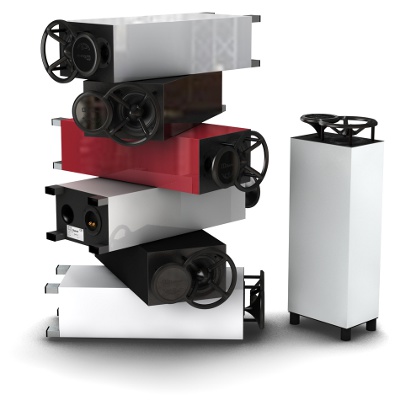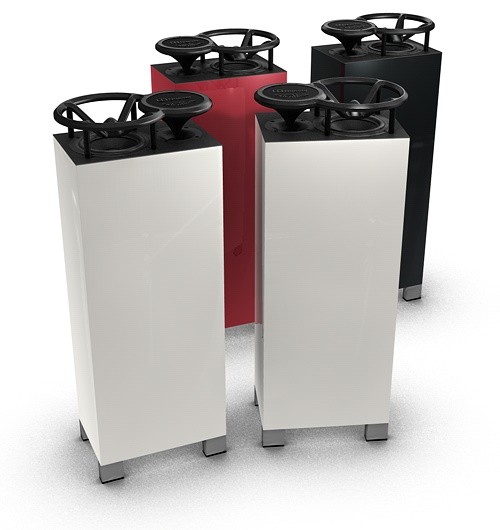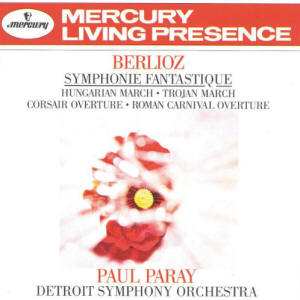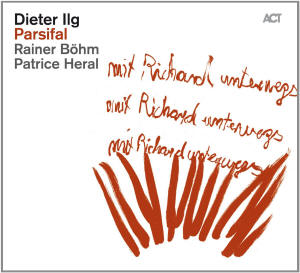|
|
You are reading the older HTML site
Positive Feedback ISSUE 70
duevel Enterprise Loudspeakers as reviewed by Paul Candy
I can't think of another under $3,000/pair speaker that combines this one's superb overall balance with a feeling of total musical immersion. In this day of so-called affordable $30,000 speakers that seem more concerned with making 80% of my music collection completely unlistenable than creating a greater sense of communion, Duevel's Enterprise comes as a welcomed relief. Maybe it's just me but somewhere along the line I think the high-end loudspeaker industry has taken a wrong turn somewhere. Sure, I often hear detail and nuance like never before but where's the love and why does something as wonderful and spiritually uplifting as listening to music often sound so cold and clinical? What happened? Where did we go wrong? After spending the last several weeks with Duevel's Enterprise, I don't believe I'm the only one who feels this way. I've just finished listening to Kathryn Stott's lovely set of The Complete Music for Piano of Gabriel Fauré, a generally overlooked and underappreciated composer. Delicacy, quiet introspection, serenity and a touch of melancholy are hallmarks of this music. Flamboyant large scale orchestral fireworks or grand gestures were of little interest to this sensitive composer. That this speaker, so revealing of momentum and excitement of music could so well convey the intimacy and quiet beauty of these brilliant little piano miniatures was a pleasant surprise to me not to mention a unique sense of being immersed in music. This speaker pushed all my buttons. Pitch definition and truth of timbre was superb and it had a way of flow and feel that made the hairs on the back of my neck stand on end. And it did this without making this music sound small or pinched. Neither did Stott's piano suffer from the dreaded 50 metre wide phenomenon that is all too commonly heard these days.
So what's the deal with these weird looking speakers? At first glance, this speaker doesn't remotely look like any other floor-standing speaker. Heck it doesn't look like it should even work! But just as a dragging a tiny piece of diamond tipped metal across a disc of grooved plastic shouldn't work either; this little honey of a speaker indeed works and sounds thoroughly compelling and convincing to boot. The Enterprise is a two-way design with a 17cm treated paper cone woofer with a 10cm ferrite magnet, rubber surround and die-cast aluminum basket. The tweeter is a 1” titanium diaphragm horn protected by a metal screen. Instead of firing towards the listener as with most speakers, both drivers fire straight up into a carefully sculptured plastic and carbon fibre diffusor which redirects sound in a 360-degree pattern. As it turns out, this contraption has a remarkable resemblance to Star Trek's Starship Enterprise, hence the name. Speaking of TV series, you might have noticed a pair of Duevel's Bella Lunas in episodes of House. Apparently, even the curmudgeonly Doctor House is a Duevel fan. Why disperse sound in a 360 degree pattern? According to this smallish German firm, the human brain has difficulty in differentiating between direct and indirect sound of the more common forward-firing speakers thus causing listener fatigue over time. With Duevel's omnidirectional designs, the listener's room boundaries are deliberately energized to produce a more reverberant field not unlike what one would experience in a concert hall. Duevel believes this radiation pattern is more natural and therefore more easily processed by our brains. This goes against pretty much all conventional thinking about proper loudspeaker design. Screw conventional thinking. Where would we be as a species if we relied solely on conventional thinking? Probably still living in caves. Duevel speakers are certainly different maybe even radical and they sure as hell don't sound at all like any other speaker brand I have heard. The woofer is loaded into a bass reflex enclosure with a bottom mounted port. In order to maintain proper distance between port and floor, the cabinet sits on 4 raised feet. Adjacent to the port are a single pair of binding posts. Due to the location of the binding posts forget stiff and/or thick speaker cables. You'll need something more flexible. For the most part I used Actinote's Aria cabling which just barely fit.
The crossover is described as phase linear on Duevel's website, with a 4-ohm impedance and modest 87dB sensitivity. My loaner pair sported a nice gloss piano black finish. White and Ferrari Red are also available. Each MDF cabinet weighs 15kg and measures 83cm (H) x 30cm (W) x 20cm (D). Claimed sensitivity is 87dB/1W/1m, nominal impedance is 4 Ohms and nominal power rating is 60W RMS. However, real in-room sensitivity is said to be significantly higher as the normal measuring procedure only captures a fraction of the acoustic output of an omnidirectional speaker like the Enterprise.
Peering under the hood, I noted what appeared to be some type of acoustic foam and reasonably thick MDF panels with the interior divided into two connected compartments. The crossover is mounted behind the binding posts and is a series type crossover rather than the more common parallel variety. In a series network, all the crossover components are aligned in a single electrical path between hot and ground which also includes the drivers themselves. Since every element in the crossover loads every other element, there are a huge number of variables that can make series crossovers difficult to design, hence their rarity. Some key claimed benefits of series networks over parallel ones include excellent phase linearity, superior coherence between drivers and better transient response. As the drivers face upwards, they tended to collect a considerable amount of dust. I used a small brush to keep dust bunnies at bay. All in all I thought the Enterprise was certainly distinctive yet attractive and well finished.
The Enterprise sits between Duevel's entry level Planets and the Venus. I reviewed the former several years ago for 6moons and I recall being impressed with the Planets especially for the modest price. Duevel's more upscale speakers incorporate superior drivers and clever design features such as true omnidirectional horn-loaded tweeters. Placement was relatively straight forward. Unlike most speakers, the Enterprise sounded decent placed just about anywhere, just as long as it was positioned in such a way that both drivers were parallel to the back wall. However, they do offer greater reward with a little effort in placement. My loaners ended up pretty much where all speakers do; about 4 feet from the back wall and 2-and-a-half feet from the side walls. I arranged them so that the tweeters were closer to the side walls. You may prefer them on the inside. It's not critical but more personal preference. Because of the way they deliberately interact with a room's surfaces, nothing quite presents music like an omnidirectional speaker. The sound did not appear to be coming from the speakers or the space between them but from the entire room. As a result, there was a significantly wider sweet spot than most speakers provide. One needn't sit in the so-called sweet spot. Sitting a foot or two outside the ideal position didn't produce a dramatic change in tonal balance or adversely affect musical focus. It's not unlike sitting off center in a concert hall or any other music venue. Even height variations did not produce the sort of gross tonal or spatial distortions one normally hears with directional speakers. No matter where I sat or stood in my room, music remained three dimensional and focused. My listening perspective simply shifted as it would in a live setting. I've never heard that before with a loudspeaker.
Spatially, these speakers scored a hat trick by combining good image placement with the ability to preserve appropriately sized and rendered spatial relationships between performers as well as convey the size of the recording space (be it real or electronically manipulated). Regarding imaging, you will not find that chiseled in marble precision you hear with most audiophile speakers. But then again, where in the real world does live music ever sound like that? It's a strictly audiophile trait that most of us have been conditioned to accept as something essential in a loudspeaker. On the other hand, the Enterprise certainly did not offer a fuzzy, larger than life bigness, but rather made the music itself big and weighty if the recording called for it. A string quartet recorded in a small space sounded exactly like that. A Mahler symphony recorded in a concert hall also convinced. If sharply defined imaging is a must, the Enterprise may not be for you. My EVO 3's certainly have more defined imaging but they don't offer the same degree of musical immersion or spatial naturalness as the Duevel. Or put another way; think of the musical term legato which is Italian for tied together. That is the essence of the Enterprise; creating an overall harmonious interrelated wholeness in music reproduction as opposed to a list of individual audiophile traits.
Surprisingly, considering its size and cost, the Enterprise had a wide enough frequency range to sound convincing on orchestral music. Paul Paray's recording of Berlioz's Symphonie fantastique thrilled me to no end not only because of this speaker's pitch definition or grip down low but more for offering the sort of sheer excitement and the wonderful sense of scale and occasion that one normally associates with live music. And while the Enterprise's bass response was not as deep as that of my JM Reynaud EVO 3, what it gave was convincing, weighty and suitably propulsive. While I sampled all manner of music during my review time, I kept coming back to small group jazz, chamber music and solo instrument recordings mostly because I was mesmerized on how natural they sounded with the Duevels. The notion of a chamber/jazz reinterpretation of Wagner's Parsifal sure sounds pretentious at first blush. Freedom of expression and freewheeling spontaneity don't normally come to mind with Parsifal, but Dieter Ilg and company pull it off to great effect on this 24-bit/96kHz FLAC download. With the Duevels, Parsifal sounded unfettered, alive and compelling. Drums were suitably forceful and dynamically nuanced. Ilg's bass was solid, fluid, and free of any major coloration.
Also impressive was music didn't sound overly strained or distorted when I tried to push the Enterprise beyond their apparent dynamic limits. Sure they compressed music and wouldn't play any louder but I rather have that than gross distortion and port chuffing. The Enterprise was also more forgiving of lousy sounding but still very cool recordings. Try playing Matthew Sweet's Girlfriend or better yet some Husker Du on your typical high-end loudspeaker and see how far you get. You'll be running for your Diana Krall or Crap at the Pawnshop in no time. Sure, I was aware of less than pristine recording quality but it wasn't thrust at me like an icepick through my ears. I was still able to connect with the music. Good audio equipment should never limit what genres of music or recording quality you listen to. If it does, it's broken as far as I'm concerned. With the Enterprise, I could listen to whatever struck my fancy and for as long as I wanted. No doubt you'll hear greater refinement, frequency extension and transparency with Duevel's larger models but it will cost you. The Enterprise offers a great deal of that but at significantly less damage to your wallet.
No speaker is perfect and neither is the Enterprise. It never quite lost a very slight woody quality that for example made Jean-Guihen Queyras's cello in Bach's Cello Suites sound a small shade thicker than I think it should. They didn't quite have the bass extension or top end sparkle and refinement as the more than twice as expensive JM Reynaud EVO 3. Yet, these nits were slight and far preferable to the boom and sizzle typically found in speakers around this price range and were also dwarfed by this speaker's tremendous musical expressiveness. The Enterprise is the total antithesis of the typical modern audiophile loudspeaker which is becoming increasingly, to me at least, more analytical, more bloodless and ultimately less human in this drive for absolute truth. I like my music served up naturally not ruthlessly dissected apart some twisted vivisectionist's table of horrors. Unfortunately I heard far too much of the latter at the recent TAVES exhibition in Toronto. The Enterprise is also not what I'd call a pipe and slippers speaker where music is a little distant and cozy sounding. This is for those who crave a more immediate, immersive listening experience. Nor did they tire or wear on me. If you dig these sorts of things from a hi-fi system, a pair of Enterprises (or is it Enterprise?) won't see a lot of down time in your home. In conclusion: The Duevel Enterprise is an cool-looking mid-sized floor-stander that will have friends and family initially oohing and aahing over its appearance and then smiling and moving their feet upon hearing them. They go fairly deep if not quite to earth-shattering synthetic droid bass levels that recordings such as Flying Lotus's Until the Quiet Comes crave. Occasionally some instruments sounded a little thicker than perhaps they really are but everything's so bloody well balanced I doubt you'll notice. The Enterprise was wonderfully alive and visceral with a superb sense of legato and human feel. They can be driven by modestly powered amps and you can place them just about anywhere in a moderate sized room. And as I alluded to at the top, I can't think of another $3000 loudspeaker I'd rather have. Terrific value and highly recommended. Paul Candy
Enterprise Loudspeakers
Duevel Canadian & US Distributor
Mutine |













